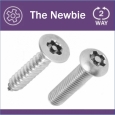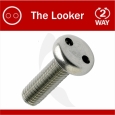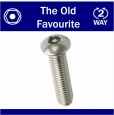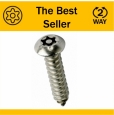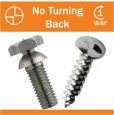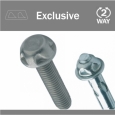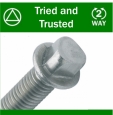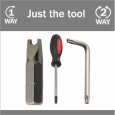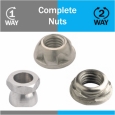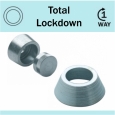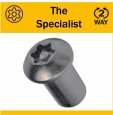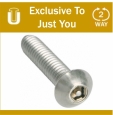Security Screws & Fixings
Thousands of security screws, bolts and nuts held in stock. Same day dispatch if ordered before 3:30pm, Monday-Friday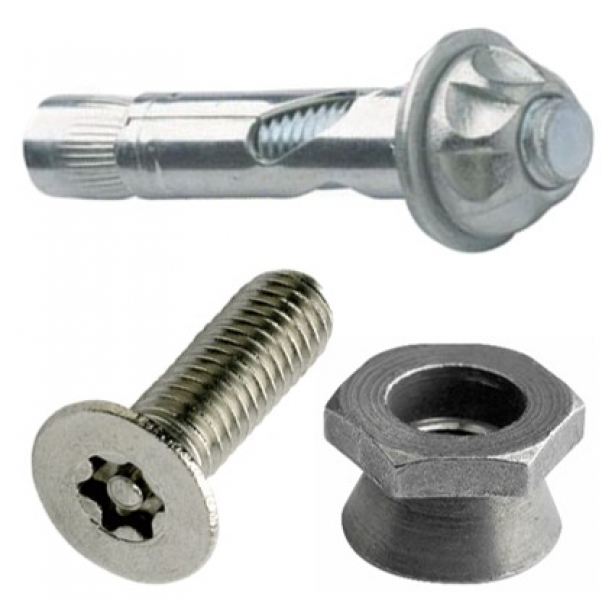
Selecting the right security screw for the job
Essentially when choosing a security fixing there is one question you must ask yourself first of all:
“Once affixed, will I ever need to remove this screw at a later date?”
If the answer is yes, you will need to purchase a two-way security screw along with a driver insert or socket. Although SSP Direct do a number of two-way fixings, including tri-head screws, oval pan machine screws and Kinmar machine bolts, the three most extensive range of fixings are available as snake eye screws (aka Pig nose or two way screws), pin hex fixings and pin torx screws. Below we briefly consider the merits of all three.
Snake Eye Screws
Historically, the most popular screw has long been the snake eye screw or bolt. This is principally because it is the most well known to the novice and because of its aesthetic appeal. Of course when it comes to looks this is a matter of taste, but this is certainly borne out over many conversations with our customers. Where snake eye screws fall down is when they are required for applications where they must be excessively tightened. With a relatively low torque threshold, these screws are not ideal in this sort of instance.
Pin Hex and Pin Torx Screws
Arguably there is little to choose between these two security pin screws. Both have a far higher torque rating than snake eye screws, meaning they can be tightened to almost any level you require without the driver insert, wrench or screwdriver breaking. That said, the pin torx screw, with its 6 lobe configuration, performs better in torque rating under strict test conditions. It is for this reason that the Pin Torx screw is often favoured by industry professionals.
Combining two or three security screws for a greater level of security
Although there is a number of tools for each range and size of screws, every now and then the driver inserts or wrench sometimes do find their way into the wrong hands. To help further safeguard against opportunist theft, often the security professional will use a combination of screw types. For example SSP Direct have just recently supplied both pin hex security fixings and pin torx ones to a company that makes playground apparatus.
5 lobe Pin screws
These are seen very much as the next level up. These A4 security screws are now available form stock.
This 5 lobe security bolt is by far our most secure standard two-security fixing. This is because - unlike the 6 lobe pin torx screws and pin hex screws - the driver inserts for attaching and removing these bolts are not readily available from standard DIY outlets.
The other benefits of these bolts is that they can be used anywhere – on land or sea. Being manufactured A4 stainless steel these can be used almost anywhere, including marine applications, within food processing and distribution, on or around medical equipment and in coastal towns and villages.
U-Nique Screws - the Ultimate Two Way Security Fixings
The only fixing more secure than a 5 lobe pin is one that is made uniquely for you.
Using SSP’s patented head design we can make a screw head and driver insert just for you. This screw will be unique from any other screw previously made and the design will be registered to ensure this screw is never made again for anyone but you. Taking up to 8 weeks to produce, customers of this product are often those that are looking to safeguard high value goods on display - like jewellery, mobile phones, tablets or computers.
One-way screws
Sometimes our customers come to us asking for screws that permanently affix items down. This is where permanent one-way security fixings come in.
In terms of one-way screws, the fixing that most people know is the clutch head screw. Tightened by a standard flat head screwdriver, this screw is difficult to remove (although if it is made from A2 stainless steel SSP’s clutch head removal tool may give you some assistance).
Where the purchaser wants to affix multiple one way screws they may also wish to consider Sentinel screws. Sometimes referred to a security Phillips screws, these require just a standard cross head Phillips/pozi drive screwdriver to attach. The key benefit of this screw over a clutch head screw is they are far easier to attach using an electric screw driver or drill.
Security Nuts
Much like security screws, there are two types of security nuts: one way permanent nuts and two way removable nuts.
Of the one ways security nuts, the most common are the shear nut. Available in three different materials – Galvanised steel, BZP and A2 stainless steel - these are attached using a standard spanner or wrench. When the nut gets to a certain level of torque, the hex shape at the top of the nuts breaks off leaving a cylindrical dome that cannot be easily removed using a standard tool.
Similar to the snake eye screw, the only downside of the shear nut is the level that it can be tightened to. The alternative to a shear nut is a Kinmar permanent nut. This security nut is far better, as the operator/fitter has greater control over the level of tightness.
This patented Kinmar design also comes in a two-way removable style. To affix the user must use the relevant socket. Much like the driver insert of the five lobe pin screws, it is SSP Direct’s company policy to never supply this socket to anyone other than a previous purchaser of the nut or to someone who is buying the Kinmar nuts at the same time as buying the socket.
Finally on security nuts there is the Scroll nut. Again SSP Direct will never sell the socket separately without good reason. As such, the chance of someone removing this nut or the Kinmar removable nut is greatly reduced.
All of the above products are available from stock on a next working day basis if ordered before 4pm, Monday-Friday.
Possible Applications
- Electrical Socket Box Screws - Snake Eye, Pin Hex or Pin Torx M3.5mm raised countersunk screws
- Number Plates – Clutch head self tapper gauge 8 or 10
- Mini-Wing mirror – Pin torx (size not shown for security reasons)
- Plaques: Pin torx or pin hex self tappers
- Playground apparatus: Pin torx and pin hex machine screws
- Retail display stands: M3, M4 or M5 security machine screws
- Vehicle roof racks: Kinmar removable nuts
Palisade fencing: Galvanised Shear nuts
FAQs | Frequently asked questions about Security Fixings
What are the most secure of all security screws?
The bottom line is the most secure of all security screws is the one that cannot be removed by anyone…not even the person that attached it in the first place! It is for this reason that sentinel screws, clutch head screws and permanent Kinmar bolts are the most secure of the lot as these are all one-way screws. That is to say they can be turned one way to screw them in but not the other way to remove.
In terms of two way screws, the most secure screws are those that have a unique head and driver insert. SSP’s U-nique range of fixings take 6 week to manufacture. Once made, we will register the design so no one else will receive the same driver insert or screw head from us.
Working down the list the next most secure is the 5 lobe screw. Like the U-nique screws these are made to order. We also keep a very tight control over who can order the corresponding driver insert.
It is also worth noting that the pin hex, pin torx, snake eye, tri head and oval pan screws remain an extremely good way of preventing theft and securing valuables. This is because none of the driver inserts, wrenches or security screwdrivers are readily available to the public through local hardware stores or the big DIY chains.
Can I remove a clutch head screw?
The only clutch head screw that you may be able to remove are the ones that are made from A2 stainless steel. To test if you have clutch head screws made from A2 stainless steel take a magnet to it. If the magnet sticks, is not stainless steel. However, if it is stainless steel a clutch head removal tool may be used on it.
The clutch head removal tool had two ultra-tough tungsten tips. When brute force is used these tips can be driven into the comparatively soft A2 stainless steel screw head. Making two divot holes, the screw may then be turned to remove it. That said, this is not an exact science and certainly not the easy option! It will still take a lot of effort.
Why can’t normal tools be used to remove security pin screws?
Pin hex and pin torx screws both have a pin in the middle so normal hexagonal allen keys, Torx bits or flat blade screwdrivers cannot be inserted. Only a special driver insert or tool with a recess for the pin to fit into will remove the screw or bolt.
Can I use a stainless steel bolt with the galvanised steel nut?
One of the biggest issue we have is customers combining Security nuts and security bolts of dissimilar metals eg, combining A2 stainless steel pin torx machine bolts together with galvanised steel Kinmar security nuts. Initially this nut and bolt set up will fit together and the installer may be happy with their day’s work. However, over time the difference in metal will start a chemical reaction, leading to deterioration of one or both parts. Ultimately this could lead to the nut jamming or, worse still, becoming loose - thus defeating the object of using security fixings. As a rule, if a nut is to be used with a machine bolt, they should both be made from the same type of metal.
Can Security screws be used on solar panels?
Because of the high value of solar panels and the growth in solar panel theft both in the UK and abroad, more and more domestic customers are turning to security screws. Whilst the cost may be higher than standard fixings they are preventing the theft of thousands of pounds of equipment. Recognising that the panel may need to be removed at some point in the future, one customer in France recently bought three different styles of M5 security screws to lock down his new solar panels after the last set of panels were stolen.
Will SSP sell to anyone outside of the UK?
Yes. Whilst the website will not allow a purchase online we will happily take orders from anywhere around the world. For ease, it is best for the customer to email or ring through details of the products they are looking to buy. We will then provide a carriage cost and timescale for shipping the products to them. They can then pay by either credit card, bank transfer or even cheque.
What does torque actually mean?
The word torque is the measure of rotational force. Torque comes in many different forms. Whether you are trying to undo a lid with your hands or tightening a screw with a screwdriver, you are dealing with the turning force or twisting action that is ‘torque’.
In the case of machine or self tapping screws this relates to how much turning force is required to move an object. With screws this is the turning force that a screwdriver needs to rotate the axis of a screw.
When this website refers to level of torque that a screw can be tightened to, we are referring to how far the screw can be tightened without either the screw head or driver insert/screwdriver/wrench yielding and becoming damaged.
How do I find out what size nut or machine screw I need?
It couldn’t really be much easier. Simply measure in a straight line across the diameter of the screw’s thread (the bit that screws in). If its 8mm across you are looking at an M8 screw. Likewise, if the hole in a nut is 8mm wide then it is an M8 nut.
What is a self tapper or self tapping screw?
A self tapper is a screw that can "tap" itself into metal via a pre-drilled hole. This is done by gradually tightening and relaxing the screw into the hole allowing the hardened thread to create a threaded hole.
Differentiated from machine screws by having a point at the end, these screws can also used to screw into wood or a wall plug into a wall.
What do the gauges on a self tapping or self driller screw actually relate to?
Like machine screws, the gauge of a screws relates to the diameter across the threads of a screw (the thickness of the shaft of the screw). Unlike the machine screw it not quite as straightforward to work out what size you actually need! The following should help you decipher how wide each gauge is:
6 Gauge Screw = 3.5mm wide thread
8 Gauge screw = 4.2mm wide thread
10 Gauge Screw = 4.8mm wide thread
12 Gauge Screw = 5.5mm wide thread
14 Gauge Screw = 6.3mm wide thread
Why is an 25mm long button head screw longer than a 25mm countersunk screw?
When measuring countersunk screws – be they security or otherwise – the total length of the screw is taken into account as most of the head sinks into the surface. However, when measuring a button or pan head screw it is just the threaded area below the head that is measured. The head itself is not part of this measurement.
Can you buy brass plated security screws?
Frequently customers ask for brass security screws to enable them to securely affix their signs or plaques to benches, walls and for other exposed, external applications. Whilst none of our screws are available in brass as standard, virtually all of our fixings can be brass plated so they do not take away from the appearance of your sign or plaque. The process takes around 10 workings days and invariably adds around £100 to the cost – whether you are order 10, 100 or 1000. That said, we also have a very small stock of screws that have been over-runs from previous brass plating jobs. As such, if you need, say, just four screws it may be worth ringing or emailing us with the approximate size and we can see if we have a handful of screws in a suitable size.
Can standard fixings be converted into security fixings?
There are two products that would enable you to do this. The first is the for use on a hex bolt or nut. By taking the conical shaped armour ring and hammering it over the top of the nut/bolt, it locks itself into position, making your standard fixing almost immovable. Be warned though, once you have done this, you will not be able to remove it yourself! The same is also true of the ingenious NoGo fixings. Designed to encase the head of a standard bolt, once the top of the NoGo is secured there is no way back! For more information on these two products, please use the Product Search at the top of this page.
Why doesn’t anyone supply wrenches for snake eye/pig nose 2 hole screws?
Allen key style, ‘L’ shaped wrenches for snake eye screws are not manufactured because of the two-dimensional aspect of this security screw. That is to say because snake eye screws rely on only two points of contact arranged in a parallel fashion, positioning a wrench from the side and turning it consistently so no damage occurs to either the screw head or the tool is virtually impossible. Critically, the tool that tightens and removes a snake eye screw must be approached head on. As such, driver inserts, fixed screwdrivers and magnetic screwdrivers (that accept snake eye driver inserts) should be used.
Should you use snake eye driver insert in drills or electric drills?
You certainly can use snake eye drivers inserts in drills and electric screwdrivers. However, in our experience, if you have 100 snake eye screws to attach you will almost definitely need more than one driver insert.
It is perhaps worth noting that because of the two points of contacts on the snake eye screw’s head, fast rotating drills or electric screwdrivers can easily cause breakages of the TH range of driver inserts and damage to the screw head itself. Arguably, if the user has the time and inclination, they may be better off affixing their snake eye screws with a magnetic screwdriver that hold their TH driver insert.
Can SSP source tools for screws that they don’t sell?
In short usually the answer to that is yes. In truth we often surprise ourselves by what we can source. All you would need to do is send us a picture of the screw head you are looking to find a corresponding tool for. We would also need you to supply as many relevant measurements as you can.
The only other thing we would say is SSP Direct are extremely protective about the industry we earn a living from. Much like the sale of standard security tools, we are very keen to make sure these tools do not fall into the wrong (potentially criminal) hands. As such, you will need to be prepared to answer a number of questions as to who you are, who you work for and most importantly why you are removing the screws. We hope you will be understanding as to why we are interrogating you in this way!
Video Transcript;
Hello.
My name is Gwyn, the company is SecuritySafetyProducts, or as we are also known, SSP Direct.
In this article, I would like to talk about security screws. I would like to try and break the subject down - losing all of the technical jargon and just talk to you about the benefits of security screws, when they should be used and how they should be used.
Most importantly, when it comes to selecting the right security screw, you have to ask yourself one question - 'At any point in the future, will I need to remove this security fixing?'
If the answer to this question is yes, then you need a two way security screw.
Now, there are a number of different security screws that you can use. SSP Direct supply a number of products, including Oval Pan screws that are designed to look like rivets, Tri-Head screws that are specially designed for street furniture, and also our recently introduced Kinmar bolt.
However, in this video I would like to tell you about our three 'main' security fixings. These are:
Snake Eye screws, also known as two hole or pig nose screws;
Pin Hex screws;
And Pin Torx security screws.
We offer machine bolts and self-tapping screws in all our popular screw types, but we also supply a raised countersunk head for protecting electrical socket boxes.
First of all Snake Eye screws. These are arguably the most common of all the security screws we offer. This is primarily because if the novice knows of any security fixing, it will be a Snake Eye screw.
Secondly, it's because of its aesthetic appeal. Of course, beauty is in the eye of the beholder but certainly the feedback from our customers seems to suggest that this is the best looking of all the security screws. Where Snake Eye screws fall down is when they are required for applications where the screw is required to be tightened excessively. With its relatively low torque threshold the Snake Eye screw isn't always the best, and it's in this instance the user may want to consider some of the other security fixings available.
Next, we have Pin Hex security fixings. This range of screws has grown considerably in its popularity in recent years. This is because it has a far greater torque rating than the Snake Eye screws. It also has a far greater range in terms of sizes and styles.
Finally, we have Pin Torx security screws. This is arguably the best option because whilst there is little to choose between the torque rating of the Pin Hex screw and the Pin Torx screw, under test conditions the 6 lobe configuration on the Pin Torx performs slightly better.
It is for this reason that the Pin Torx range of screws is the screw of choice for the industry professional. A mixture of Pin Torx and Pin Hex machine screws are ideal for securing playground apparatus and any application where there is likely to be a concerted attempt to remove the product that has been fixed. This is primarily because, whilst there are a number of different sizes of driver inserts for any of our security fixings, sometimes the driver inserts or wrenches can find their way into the wrong hands. To prevent the opportunist theft, increasingly, companies like playground apparatus firms will use more than one security fixing on any given piece of apparatus. For example, we've just sold one playground company both Pin Hex and Pin Torx to be used on a roundabout.
Moving up from our standard range we have the 5 Lobe security screw. This is a range of screws that are made to order - so when we receive an order it usually takes us two weeks to produce these self tapping screws for you. Critically, it's seen as the next level up because of the control that we have over the driver inserts. We'll never sell a driver insert for a 5 lobe security screw to anyone other than an existing customer.
The only security fixing that is more secure than a 5 lobe security screw is a bespoke screw that is made specifically for you. Using SSP's patented head design, we can develop a screw that's never previously been sold to anyone else. We will also register the head design of that screw to ensure that no one in the future is able to buy a security screw like yours or more importantly obtain a tool capable of unscrewing one of your screws. Taking up to 8 weeks to produce, these screws are invariably used for high value goods that are on display - such as within a jeweller's, or within a technology shop of some kind, where the client is demonstrating and selling mobile phones, tablets or computers.
Going back to the question at the start of this overview, sometimes people want to use a security screw that they don't want to remove at a later date. In this instance, they'll be looking at one of our two One Way screws.
The most common of these is the Clutch Head Security Screw. This can be simply affixed using a flat blade screwdriver. Clutch Head self tappers (Gauge 8 or 10) are ideal for affixing number plates.
Alternatively, if you're looking to insert a large number of security screws, you might want to consider the Sentinel. Rather than using a flat blade screwdriver, you can use a Philips or cross head screwdriver to affix the Sentinel. This means if you're using an electric screwdriver or drill, you can insert a number of these screws without any real delay, in the same way that you might have with a Clutch Head screw. It's for this reason that the Sentinel screw is growing in popularity over and above the Clutch Head screw.
That takes us on to security nuts. Much like security screws, security nuts come in two varieties - permanent (One way) nuts, and Two Way (Removable) security nuts.
The most common of these is the Shear Nut (a permanent fixing). Shear Nuts are available in three different materials - Galvanised Steel, A2 Stainless Steel and BZP. They're attached using a standard wrench or spanner. When the nut gets to a certain level of tightness, the hex at the top of the Shear Nut will simply break away, leaving a cylindrical dome that cannot be removed without a great deal of difficulty. Similar to Snake Eye screws, the only downside of the Shear Nut is the level of torque that this nut can be tightened to.
Shear Nuts are frequently used for palisade fencing.
The alternative to a Shear Nut, if you're looking for a nut that can be tightened to whatever level, then you really should be considering the Kinmar permanent one way nut. Using the socket provided, this can be tightened as required.
SSP's patented Kinmar Security Nut is also available in a two way version. Kinmar removable nuts have been used to affix bike racks to the top of vehicles.
Much like the driver inserts for the 5 Lobe Pins, the socket that is designed for the Kinmar will only ever be sold to customers of Kinmar nuts. We'll never sell it on its own.
Finally with regards to high security two way nuts – we come to the Scroll Nut. A precision engineered solution that has been around for a number of years but still remains very popular. Very much like the Kinmar tool, we will never sell the socket that applies to this product to anyone other than existing customers or new clients purchasing a quantity of scroll nuts. This means the chance of an opportunist theft of anything that's affixed using a Scroll Nut or a Kinmar is greatly reduced.
Finally, I would like thank you ever so much for taking time out to watch this video. I genuinely hope it's been of some use.
If you have any queries relating to security screws, SecuritySafetyProducts has been selling security fixings for well over a decade now. If you have any queries of a technical nature, please ring us on 0844 997 0101 or we can be emailed at [email protected]
Thank you.




 2,632 reviews
2,632 reviews



